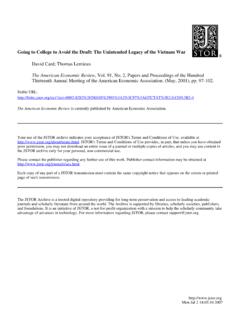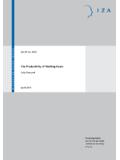Transcription of Minimum Wages and Employment: A Case Study of ... - David …
1 Minimum Wages and Employment: A case Study of the Fast-Food Industry in New Jersey and Pennsylvania On April 1, 1992, New Jersey's Minimum wage rose from $ to $ per hour. To evaluate the impact of the law we surveyed 410 fast-food restaurants in New Jersey and eastern Pennsylvania before and after the rise. Comparisons of employment growth at stores in New Jersey and Pennsylvania (where the Minimum wage was constant) provide simple estimates of the effect of the higher Minimum wage. We also compare employment changes at stores in New Jersey that were initially paying high Wages (above $5) to the changes at lower-wage stores. We find no indication that the rise in the Minimum wage reduced employment. (JEL 530, 523). How do employers in a low-wage labor cent studies that rely on a similar compara- market respond to an increase in the mini- tive methodology have failed to detect a mum wage?
2 The prediction from conven- negative employment effect of higher mini- tional economic theory is unambiguous: a mum Wages . Analyses of the 1990-1991 in- rise in the Minimum wage leads perfectly creases in the federal Minimum wage competitive employers to cut employment (Lawrence F. Katz and Krueger, 1992; Card, (George J. Stigler, 1946). Although studies 1992a) and of an earlier increase in the in the 1970's based on aggregate teenage Minimum wage in California (Card, 1992b). employment rates usually confirmed this find no adverse employment impact. A Study prediction,' earlier studies based on com- of Minimum -wage floors in Britain (Stephen parisons of employment at affected and un- Machin and Alan Manning, 1994) reaches a affected establishments often did not ( , similar conclusion. Richard A. Lester, 1960, 1964).
3 Several re- This paper presents new evidence on the effect of Minimum Wages on establishment- level employment outcomes. We analyze the experiences of 410 fast-food restaurants in *Department of Economics, Princeton University, New Jersey and Pennsylvania following the Princeton, NJ 08544. We are grateful to the Institute increase in New Jersey's Minimum wage for Research on Poverty, University of Wisconsin, for from $ to $ per hour. Comparisons partial financial support. Thanks to Orley Ashenfelter, Charles Brown, Richard Lester, Gary Solon, two of employment, Wages , and prices at stores anonymous referees, and seminar participants at in New Jersey and Pennsylvania before and Princeton, Michigan State, Texas A&M, University of after the rise offer a simple method for Michigan, university of Pennsylvania, ~niversitJ of evaluating the effects of the- Minimum wage.
4 Chicago, and the NBER for comments and sugges- ~~~~~~i~~~~ within N~~ jerseybetween tions. We also acknowledge the expert research assis- tance of Susan Belden, Chris Burris, Geraldine Harris, high-wage paying and Jonathan Orszag. than the new Minimum rate prior to its 'see Charles Brown et al. (1982,1983) for surveys of effective date) and other stores provide an this literature. A recent update (Allison J. Wellington, alternative estimate of the impact of the 1991) concludes that the employment effects of the Minimum wage are negative but small: a 10-percent new lawe increase in the Minimum is estimated to lower teenage In addition to the simplicity of our empir- employment rates by percentage points. ical methodology, several other features of 772. VOL. 84 NO. 4 CARD AND KRUEGER: Minimum WAGE AND EMPLOYMENT 773.
5 The New Jersey law and our data set are and 1991 to measures of the relative mini- also significant. First, the rise in the mini- mum wage in each state. mum wage occurred during a recession. The increase had been legislated two years ear- I. The New Jersey Law lier when the state economy was relatively healthy. By the time of the actual increase, A bill signed into law in November 1989. the unemployment rate in New Jersey had raised the federal Minimum wage from $ risen substantially and last-minute political per hour to $ effective April 1, 1990, action almost succeeded in reducing the with a further increase to $ per hour on Minimum -wage increase. It is unlikely that April 1, 1991. In early 1990 the New Jersey the effects of the higher Minimum wage legislature went one step further, enacting were obscured by a rising tide of general parallel increases in the state Minimum wage economic conditions.
6 For 1990 and 1991 and an increase to $ Second, New Jersey is a relatively small per hour effective April 1, 1992. The sched- state with an economy that is closely linked uled 1992 increase gave New Jersey the to nearby states. We believe that a control highest state Minimum wage in the country group of fast-food stores in eastern Pennsyl- and was strongly opposed by business lead- vania forms a natural basis for comparison ers in the state (see Bureau of National with the experiences of restaurants in New Affairs, Daily Labor Report, 5 May 1990). Jersey. Wage variation across stores in New In the two years between passage of the Jersey, however, allows us to compare the $ Minimum wage and its effective date, experiences of high-wage and low-wage New Jersey's economy slipped into reces- stores within New Jersey and to test the sion.
7 Concerned with the potentially ad- validity of the Pennsylvania control group. verse impact of a higher Minimum wage, the Moreover, since seasonal patterns of em- state legislature voted in March 1992 to ployment are similar in New Jersey and phase in the 80-cent increase over two years. eastern Pennsylvania, as well as across The vote fell just short of the margin re- high- and low-wage stores within New Jer- quired to override a gubernatorial veto, and sey, our comparative methodology effec- the Governor allowed the $ rate to go tively "differences out" any. seasonal em- into effect on April 1 before vetoing the ployment effects. two-step legislation. Faced with the prospect Third, we successfully followed nearly 100 of having to roll back Wages for Minimum - percent of stores from a first wave of inter- wage earners, the legislature dropped the views conducted just before the rise in the issue.
8 Despite a strong last-minute chal- Minimum wage (in February and March lenge, the $ Minimum rate took effect 1992) to a second wave conducted 7-8 as originally planned. months after (in November and December 1992). We have complete information on 11. Sample Design and Evaluation store closings and take account of employ- ment changes at the closed stores in our Early in 1992 we decided to evaluate the analyses. We therefore measure the overall impending increase in the New Jersey mini- effect of the Minimum wage on average mum wage by surveying fast-food restau- employment, and not simply its effect on rants in New Jersey and eastern Pennsylva- surviving establishments. niae2 Our choice of the fast-food industry -Our analysis of employment trends at was driven by several factors. First, fast-food stores that were open for business before stores are a leading employer of low-wage the increase in the Minimum wage ignores workers: in 1987, franchised restaurants em- any potential effect of Minimum Wages on the rate of new store openings.
9 To assess the likely magnitude of this effect we relate state-specific growth rates in the number of 2At the time we were uncertain whether the $ McDonald's fast-food outlets between 1986 rate would go into effect or be overridden. THE AMERICAN ECONOMIC REVIEW SEPTEMBER 1994. Stores in: A1l NJ PA. Waue I, February 15-March 4, 1992: Number of stores in sample frame:a 473 364 109. Number of refusals: 63 33 30. Number interviewed: 410 331 79. Response rate (percentage): Wace 2, Nocember 5 - December 31, 1992: Number of stores in sample frame: 410 331 79. Number closed: 6 5 1. Number under rennovation: 2 2 0. Number temporarily closed:' 2 2 0. Number of refusals: 1 1 0. Number i n t e r v i e ~ e d : ~ 399 321 78. aStores with working phone numbers only; 29 stores in original sample frame had disconnected phone numbers.
10 '~ncludes one store closed because of highway construction and one store closed because of a fire. 'Includes 371 phone interviews and 28 personal interviews of stores that refused an initial request for a phone interview. ployed 25 percent of all workers in the rants in New Jersey and eastern Pennsylva- restaurant industry (see Department of nia from the Burger King, KFC, Wendy's, Commerce, 1990 table 13). Second, fast-food and Roy Rogers chain^.^ The first wave of restaurants comply with Minimum -wage reg- the survey was conducted by telephone in ulations and would be expected to raise late February and early March 1992, a little Wages in response to a rise in the Minimum over a month before the scheduled increase wage. Third, the job requirements and in New Jersey's Minimum wage. The survey products of fast-food restaurants are rela- included questions on employment, starting tively homogeneous, making it easier to ob- Wages , prices, and other store characteris- tain reliable measures of employment, tic~.






